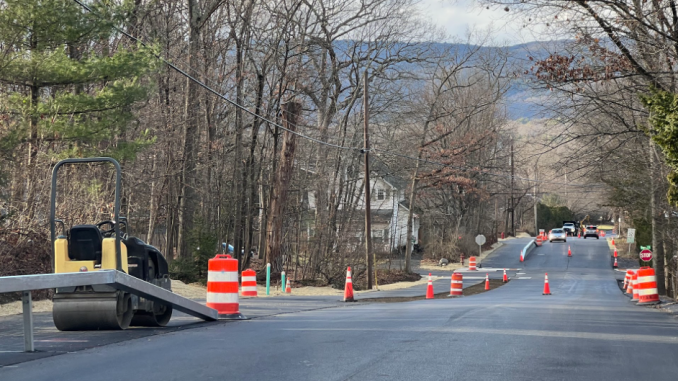
Construction of a new bike/pedestrian path on Henry W. DuBois Drive (HWD) began in May 2024 and was projected to be completed by Dec. 20. The proposed improvements span across HWD — from North Chestnut Street to the west and North Putt Corners Road to the east.
The $2.75 million project is primarily being funded by a grant received by the town from the Federal Highway Administration. The project is a Locally Administered Federal Aid Project sponsored by the Town of New Paltz. The New York State Department of Transportation (NYSDOT) is responsible for overseeing the successful implementation of the project. Eighty percent of project and construction costs are covered by the Federal Highway Administration, with the Town of New Paltz covering the other 20%.
The Whispering Pines Development Corporation of Vails Gate was awarded the construction bid and Creighton Manning Engineering, LLP of White Plains is overseeing the project for the town.
The project seeks to connect the Wallkill Valley Rail Trail to the Hudson Valley Rail Trail, opening over 30 miles of off-road cycling and hiking to users. It also forms part of the 750-mile Empire State Trail: a non-motorized trail that begins in Battery Park and will make its way upon completion all the way to Buffalo. Proponents of the project claim “shared-use paths provide safe and easy access for alternative modes of transportation that reduce emissions and traffic congestion and encourage healthy, active lifestyles,” as per Hudson Valley One.
“The HWD bike/pedestrian path will provide a safe means of alternative transportation, i.e. non-automobile, for New Paltz residents for local use on an integral east-west street, as well being a vital link for the Empire State Trail and all the folks who will come to New Paltz to travel that innovative path,” said Town Supervisor Amanda Gotto.
The design phase was completed in 2020, then due to the COVID-19 lockdown, the construction phase was put on pause. Construction finally began in May 2024, with an anticipated duration of 200 days. The contractors are working “very hard to complete all work by Dec. 31,” but may need to complete some landscape plantings in the spring.
“We need to finish it before the end of the year,” Gotto said in a public update online. “For one thing, because asphalt and paving doesn’t really happen in the winter months because of temperature issues. We can’t do the things that are temperature dependent, which are paving, but also planting … Those will have to happen when it’s appropriate.”
Construction of the path has not been linear. “The construction of the path was delayed by COVID,” Gotto said. “As a result, when the project was finally restarted and the construction contract could finally be awarded, many things had changed — availability of materials, costs, personnel, etc. We always knew the project would be a big and challenging one, covering 1.2 miles of a vital street in the town and village. There are so many parts to the whole thing — working with many property owners, getting telephone poles relocated by Central Hudson and then getting electric, phone and cable re-installed, getting town and village fire hydrants relocated, addressing re-located and new drainage systems, actualizing a design that had only existed on paper — the list goes on and on, and those were the things we anticipated beforehand.”
Concerns about the project’s progress pertain to weather constraints, with seasonal changes and extreme weather posing a challenge in that it is completely uncontrolled. “The most unexpected challenges have had to do with weather. We got Hurricane Debby washing lots of things out in August, super hot weather July, August, September and now really cold weather in November and early December. It makes it hard on the workers, the equipment and the materials,” Gotto said.
“While the construction caused a lot of mess, dust, road closures and traffic delays, so many residents, including those most directly and protractedly impacted, have been so gracious about it all. Big thanks to all who have been watching and waiting for the completion of this project.”
Beyond the construction of a bike and pedestrian path in New Paltz, the construction on HWD incorporates the Green Infrastructure Project, which will provide green infrastructure treatments along Henry W. Dubois for the purposes of treating as much of the stormwater runoff as is deemed feasible within the budgetary and physical constraints that the project corridor allows.
The Henry W. Dubois Green Infrastructure project is sponsored by the Town of New Paltz and is being funded by the New York State Department of Environmental Conservation (DEC) through a Climate Smart Communities grant. The DEC is responsible for overseeing the successful implementation of the project. Project and construction costs are split by the Town of New Paltz and the DEC, with each party covering 50%. The grant covers a portion of the design and the construction of the green infrastructure treatments.
Due to existing soil and groundwater conditions, the current treatments being explored for implementation include sand filters, infiltration trenches and the addition of trees. Any trees planted will be in addition to the landscaping proposed as part of the bike/pedestrian path project to meet the self-imposed 1:1 mitigation ratio. The tree species selected will be based on the landscaping palette approved by the New Paltz Environmental Conservation Board which reflects newest guidance by the Army Corps of Engineers. This selection guidance will improve the potential for trees to adapt to the needs of the environment due to climate change.
“In New Paltz, we want our community to have access to multimodal transportation. Public pedestrian infrastructure like the HWD bike/ped path gives local residents and visitors safe options for foregoing automobiles, not only for recreation but for normal day-to-day travel to workplaces, stores, restaurants, community facilities, etc,” Gotto said.
